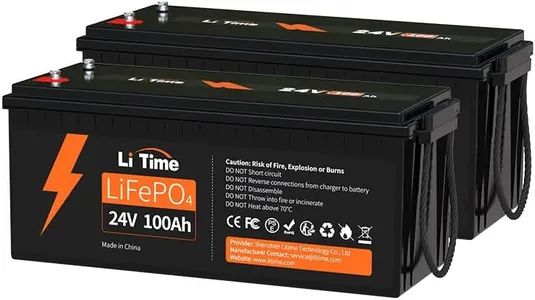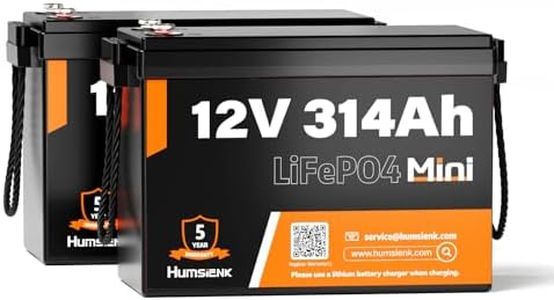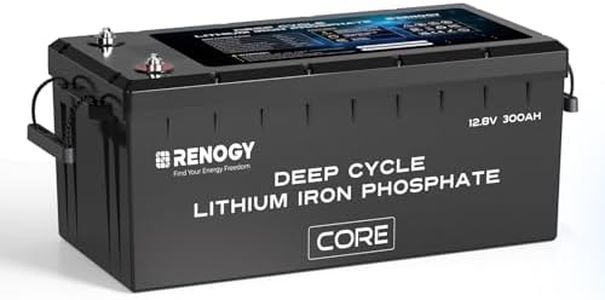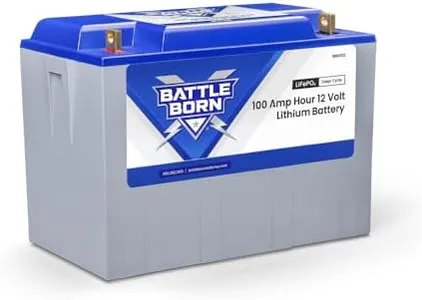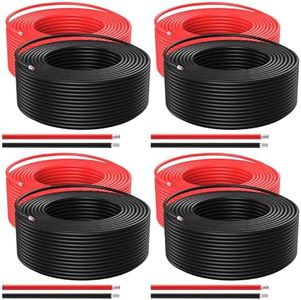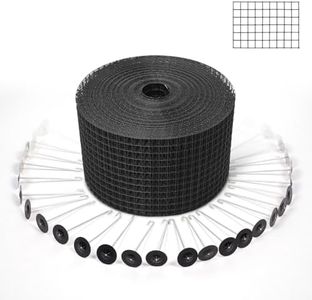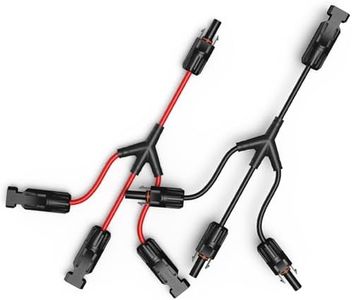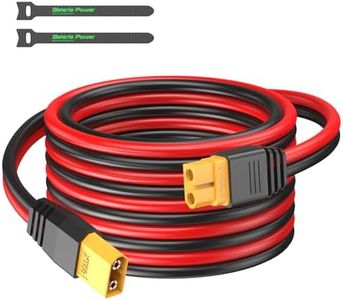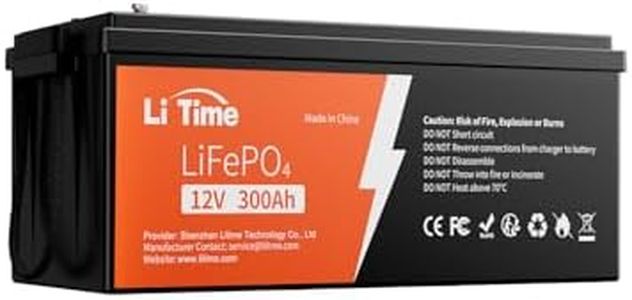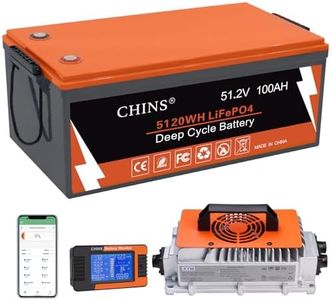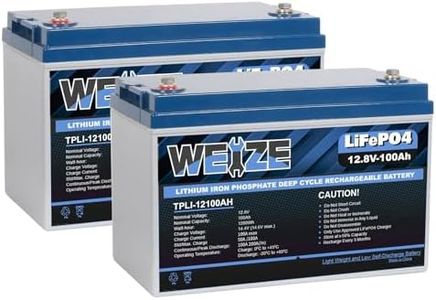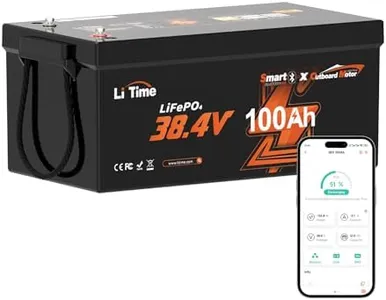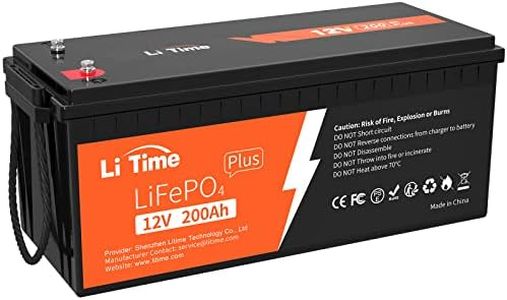10 Best Lithium Deep Cycle Batteries 2025 in the United States
Our technology thoroughly searches through the online shopping world, reviewing hundreds of sites. We then process and analyze this information, updating in real-time to bring you the latest top-rated products. This way, you always get the best and most current options available.

Our Top Picks
Winner
ECO-WORTHY 48V 200Ah LiFePO4 Lithium Battery (2 Pack 48V 100AH) w/Bluetooth | UL1973 & UL9540A & CEC Listed | 10.24KWh Server Rack Battery for Solar Energy Storage, Home Backup Power
Most important from
198 reviews
The ECO-WORTHY 48V 200Ah LiFePO4 battery pack offers a solid solution for people looking to store energy for off-grid solar setups or backup power. With a total capacity of 10.24kWh (two 48V 100Ah batteries), this battery provides a strong energy reserve that can easily handle typical household needs. Its voltage of 51.2V aligns well with many popular solar inverter chargers, making installation straightforward thanks to built-in communication features like CAN/RS485. A standout feature is its impressive cycle life, rated at up to 6000 deep cycles, meaning it can handle many charge and discharge cycles before capacity significantly drops. This longevity is backed by a robust metal casing, which also enhances durability.
The built-in Battery Management System (BMS) adds important safety by protecting against overcharging and short circuits, giving peace of mind during use. Real-time status monitoring via an indicator lamp helps users keep track of battery health easily. Each battery weighs about 200 pounds, which could make handling and installation challenging without help. While the battery supports parallel expansion up to 32 units for larger capacity needs, this may be more than what typical home users require.
This battery is well suited for users who need a dependable, long-lasting energy storage option and are prepared to manage its weight during setup.
Most important from
198 reviews
Victron Energy LiFePO4 Battery 25.6V 200Ah – Smart Lithium Battery with Integrated BMS and Bluetooth
The Victron Energy Smart 25.6-Volt 200Ah LiFePO4 Lithium Battery is a strong contender in the lithium deep cycle battery category. One of its key strengths is the safety of lithium iron phosphate (LiFePO4) chemistry, which is known for being stable and less prone to overheating compared to other lithium-ion types. With a capacity of 200Ah and a voltage of 25.6V, this battery is well-suited for a variety of applications, whether indoor or outdoor, including renewable energy systems and electric vehicles.
The battery's long cycle life and high depth of discharge (DoD) are significant advantages, allowing users to utilize a larger portion of the battery's capacity without compromising lifespan. Additionally, the Victron Energy Smart battery features integrated cell balancing, which helps maintain battery health and performance over time.
A particularly appealing feature is the Bluetooth connectivity that allows users to monitor cell voltages, temperature, and alarm status via an app. This capability is beneficial for troubleshooting potential issues early, such as cell imbalance, providing peace of mind for users. However, there are a few drawbacks to consider. The requirement of a separate Battery Management System (BMS) for proper wiring can be a hurdle for those who may not have the technical know-how or resources for installation. Also, while the battery can be connected in parallel or series for expanded capacity, this setup may not be ideal for those looking for a simpler plug-and-play solution.
12V 300Ah (314Ah) LiFePO4 Lithium Battery Max. 4019Wh, 15000+ Deep Cycles,100A BMS Lithium Iron Phosphate Rechargeable Battery Great for RV, Marine and Off Grid Applications, 2 PACK
Most important from
201 reviews
This HumsiENK 12V 314Ah LiFePO4 battery pack (2 units) is a strong choice for anyone needing reliable, long-lasting power in RVs, boats, or off-grid setups. With a high capacity of around 4.19kWh and a nominal voltage of 12.8V, it provides plenty of energy storage. What stands out most is its exceptional cycle life—over 15,000 deep cycles—making it far more durable than traditional lead-acid batteries that usually last only a fraction of that.
The battery supports nearly 100% depth of discharge, meaning you can use almost all the stored power without damaging the battery, which increases usable energy. It’s also relatively lightweight at about 62 pounds per battery and compact compared to lead-acid counterparts, making installation easier in limited spaces. The built-in 100A Battery Management System keeps the battery safe by protecting against overcharge, over-discharge, short circuits, and extreme temperatures, so it requires little maintenance.
This battery can also be expanded into larger systems if more power is needed for bigger projects or solar energy storage. It is an excellent option for users seeking a durable, safe, and versatile power solution for recreational and professional uses.
Most important from
201 reviews
Buying Guide for the Best Lithium Deep Cycle Batteries
When choosing a lithium deep cycle battery, it's important to understand the key specifications that will determine how well the battery will meet your needs. These batteries are commonly used in applications such as solar energy storage, RVs, boats, and electric vehicles. The right battery for you will depend on factors like the energy requirements of your devices, the space available for the battery, and how often you plan to use it. By understanding the key specifications, you can make an informed decision and select a battery that will provide reliable performance and longevity.FAQ
Most Popular Categories Right Now
